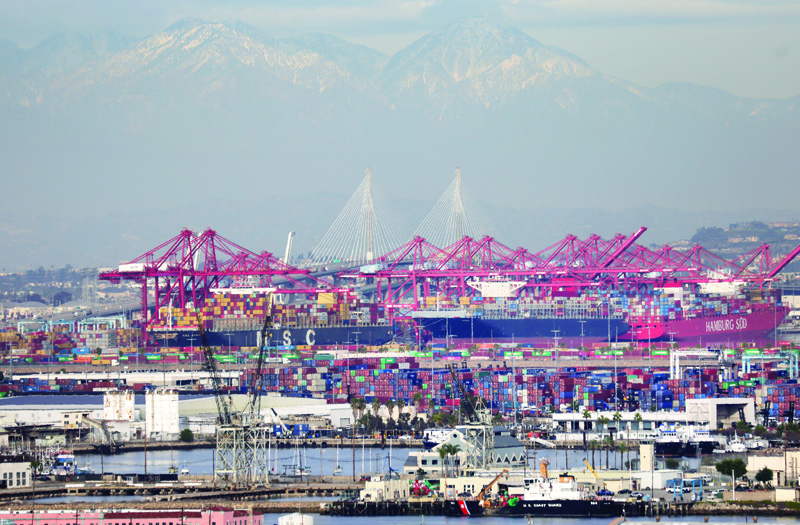 SAN PEDRO, California: Container ships and shipping containers (center) are viewed at the Port of Los Angeles with the Port of Long Beach in the distance in San Pedro, California. - AFP
SAN PEDRO, California: Container ships and shipping containers (center) are viewed at the Port of Los Angeles with the Port of Long Beach in the distance in San Pedro, California. - AFP
LONDON: Maritime container freight shipping is steaming ahead through the COVID-19 pandemic, boosted by strong demand for Chinese exports and a shortage of vessels according to industry experts. The Freightos Baltic Global Container Index (FBX), which tracks the cost of container shipping, has almost quadrupled for the China-Europe route since early November to stand at $7,827 on Friday.
The FBX reading for containers from China bound for the west coast of the United States has nearly tripled since late May to $4,286 on Friday. "The costs of shipping goods from China to Europe by water have hit unprecedented highs recently," said UniCredit Bank economist Andreas Rees. That is due to rampant demand for China's manufactured products, particularly for medical equipment during the global health emergency-but also for consumer goods from lockdown-bound populations.
'Exponential' demand increase
"First, demand of medical goods produced in China have been strongly rising. Second, and probably more important, consumers have been re-allocating their demand," said Rees. "Instead of going to restaurants and travelling, they have been demanding more durable goods such as electronic equipment, furniture, etc, to have a nice home. And many of these goods are produced in China."
That has had a knock-on effect on demand for the gigantic container ships that transport vast amounts of goods from the Asian powerhouse. "Container shipping costs are soaring from Asia, not just to the UK but to most destinations for shipments out of China and Asia," Braemar analyst Jonathan Roach told AFP. "With increased durable demand, container demand has increased exponentially."
Nevertheless, the pandemic did also spark a overall 4.1-percent decline in world maritime trade last year, according to recent estimates from the United Nations Conference on Trade and Development. Bottlenecks have however been created across the sector due to strict COVID-19 hygiene and sanitation measures in ports, logistics centers and storage depots worldwide. The turnaround time between unloading a container ship and returning has therefore increased significantly, according to Roach. That further limits the available pool of vessels.
"When there is a delay in shipping empties back to loading hubs and the same time as a cargo surge, availability of empty container equipment will tighten," Roach added. "We expect this imbalance (between supply and demand) to continue while strict Covid-19 restrictions remain in place."
Inflation fears
Rising transportation costs can meanwhile feed through into higher consumer prices and spark concern among global central banks, which keep close tabs on building inflationary pressures. "There is still the question of whether and to which extent companies can pass on higher prices to consumers," noted Rees. "As of today, only a moderate cost-push to consumer price inflation seems likely. But the pattern certainly needs to be closely monitored."
Turning to the outlook, Roach remains upbeat due to the growing global Covid-19 vaccination drive. "We do expect (consumer) spending to normalize as the vaccine rollout gathers pace-and a correction in the spending switch should normalize freight demand. We expect that to happen towards the middle of 2021." - AFP
.jpg)
